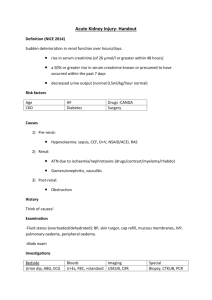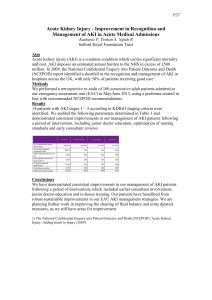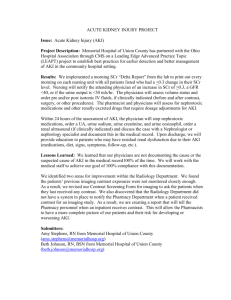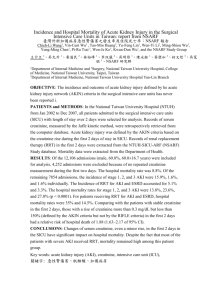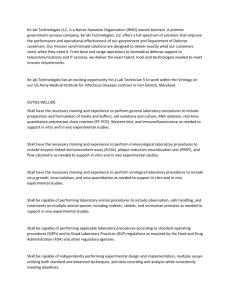An informatics solution to identify AKI in primary care
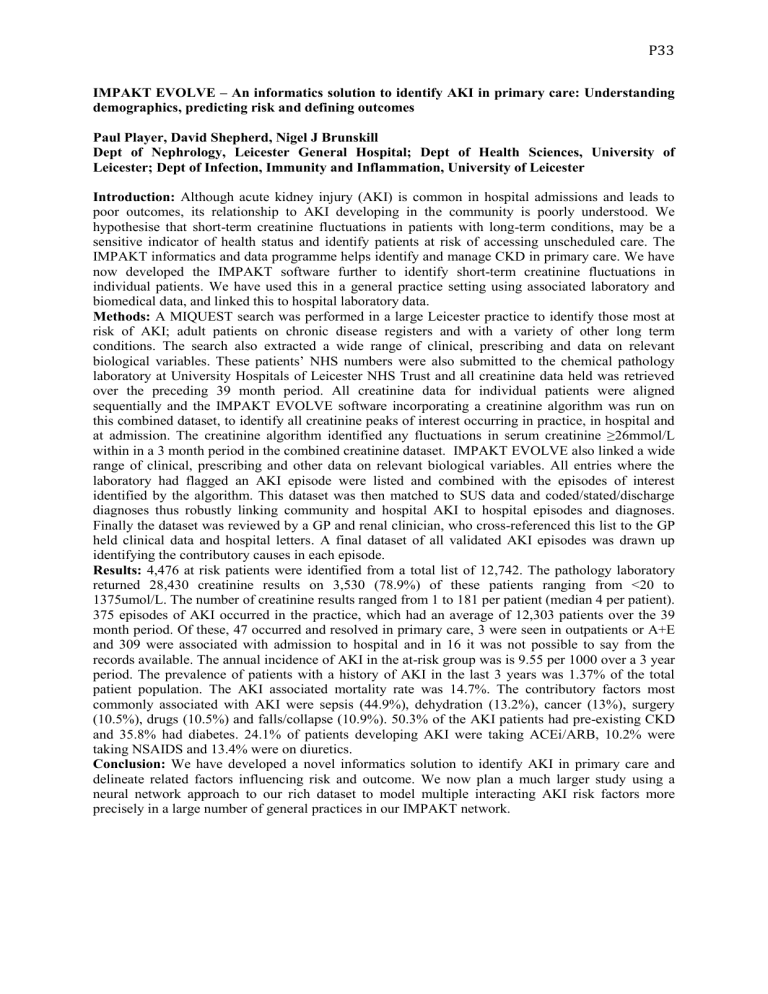
P33
IMPAKT EVOLVE – An informatics solution to identify AKI in primary care: Understanding demographics, predicting risk and defining outcomes
Paul Player, David Shepherd, Nigel J Brunskill
Dept of Nephrology, Leicester General Hospital; Dept of Health Sciences, University of
Leicester; Dept of Infection, Immunity and Inflammation, University of Leicester
Introduction: Although acute kidney injury (AKI) is common in hospital admissions and leads to poor outcomes, its relationship to AKI developing in the community is poorly understood. We hypothesise that short-term creatinine fluctuations in patients with long-term conditions, may be a sensitive indicator of health status and identify patients at risk of accessing unscheduled care. The
IMPAKT informatics and data programme helps identify and manage CKD in primary care. We have now developed the IMPAKT software further to identify short-term creatinine fluctuations in individual patients. We have used this in a general practice setting using associated laboratory and biomedical data, and linked this to hospital laboratory data.
Methods: A MIQUEST search was performed in a large Leicester practice to identify those most at risk of AKI; adult patients on chronic disease registers and with a variety of other long term conditions. The search also extracted a wide range of clinical, prescribing and data on relevant biological variables. These patients’ NHS numbers were also submitted to the chemical pathology laboratory at University Hospitals of Leicester NHS Trust and all creatinine data held was retrieved over the preceding 39 month period. All creatinine data for individual patients were aligned sequentially and the IMPAKT EVOLVE software incorporating a creatinine algorithm was run on this combined dataset, to identify all creatinine peaks of interest occurring in practice, in hospital and at admission. The creatinine algorithm identified any fluctuations in serum creatinine ≥26mmol/L within in a 3 month period in the combined creatinine dataset. IMPAKT EVOLVE also linked a wide range of clinical, prescribing and other data on relevant biological variables. All entries where the laboratory had flagged an AKI episode were listed and combined with the episodes of interest identified by the algorithm. This dataset was then matched to SUS data and coded/stated/discharge diagnoses thus robustly linking community and hospital AKI to hospital episodes and diagnoses.
Finally the dataset was reviewed by a GP and renal clinician, who cross-referenced this list to the GP held clinical data and hospital letters. A final dataset of all validated AKI episodes was drawn up identifying the contributory causes in each episode.
Results: 4,476 at risk patients were identified from a total list of 12,742. The pathology laboratory returned 28,430 creatinine results on 3,530 (78.9%) of these patients ranging from <20 to
1375umol/L. The number of creatinine results ranged from 1 to 181 per patient (median 4 per patient).
375 episodes of AKI occurred in the practice, which had an average of 12,303 patients over the 39 month period. Of these, 47 occurred and resolved in primary care, 3 were seen in outpatients or A+E and 309 were associated with admission to hospital and in 16 it was not possible to say from the records available. The annual incidence of AKI in the at-risk group was is 9.55 per 1000 over a 3 year period. The prevalence of patients with a history of AKI in the last 3 years was 1.37% of the total patient population. The AKI associated mortality rate was 14.7%. The contributory factors most commonly associated with AKI were sepsis (44.9%), dehydration (13.2%), cancer (13%), surgery
(10.5%), drugs (10.5%) and falls/collapse (10.9%). 50.3% of the AKI patients had pre-existing CKD and 35.8% had diabetes. 24.1% of patients developing AKI were taking ACEi/ARB, 10.2% were taking NSAIDS and 13.4% were on diuretics.
Conclusion: We have developed a novel informatics solution to identify AKI in primary care and delineate related factors influencing risk and outcome. We now plan a much larger study using a neural network approach to our rich dataset to model multiple interacting AKI risk factors more precisely in a large number of general practices in our IMPAKT network.
